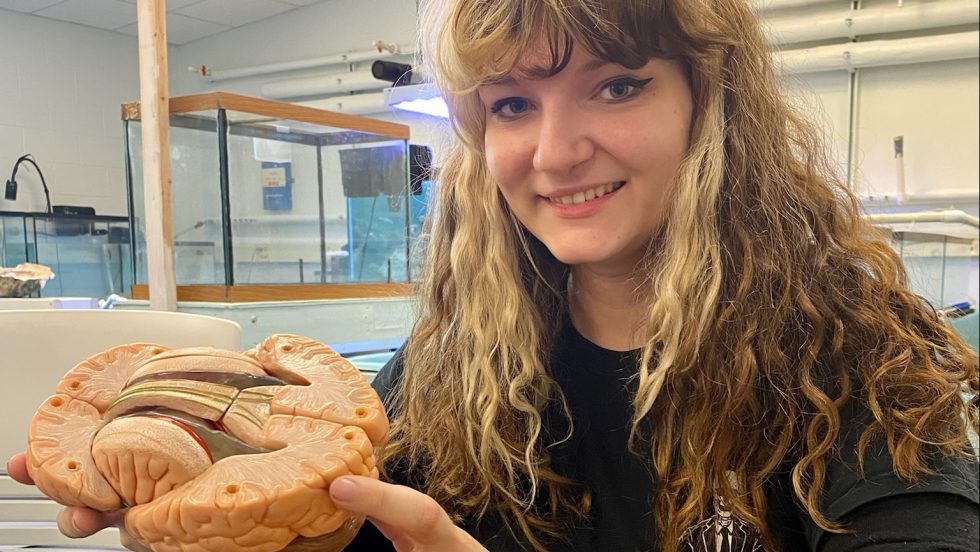How I Dived Headfirst into Neuroscience and Oceanography at New College of Florida

My first semester roster included classes in writing, sociology, oceanography and “Introduction to Neuroscience.” “Neuroscience” is a term that I have become more familiar with now that I’m in my fourth year of college, but I’ve never been immune to the (seemingly universal) visceral reaction that the word invokes. My preconceptions of what it took to study the brain were enough that I nearly didn’t take the class.
But, as the semester progressed, I found myself in oceanography classes, feeling consumed by the vastness of the ocean. I could say that I felt the tides deserved peace, undisturbed by my human examination, but—more truthfully—I had taken a liking to the study of the brain.
I don’t really understand the forces that pulled me into the area, but part of the brain’s appeal was its tangibility. If you haven’t held an anatomical 3-D model of the brain, I recommend it; it’s very satisfying. The organ fits right in your two hands, and some models let you take hearty chunks out of the pink cortex so you can stare into the brainstem (and it reminds you that the structure is keeping you breathing and your heart beating).
In my third year of studying biopsychology at New College, I took a “Laboratory in Comparative Brain Connectivity” course. My classmates and I worked with diffusion tensor imaging (DTI) to examine animal brain data gathered previously by magnetic resonance imaging (MRI).
For a little background, the brain is made up of cells called neurons that are sending and receiving signals from other neurons. These cells are physically connected and communicate in networks. When processes are closely related, strong pathways or connections between the associated brain areas are expected. The DTI data uses water diffusion—an indicator of neural pathways—to allow us to make structural inferences about the brain.
So I started thinking about the brains for which we had data—those of otters, seals and other marine mammals. I knew that sea otters had interesting appendage uses and wondered if neural projections would differ between sea otters and harbor seals. When marine mammals went back to the water over seven lineages, harbor seals returned sooner than sea otters. As a result, evolution left sea otters with highly sensitive forepaws for predation and harbor seals with fore flippers for steering (so that they could swallow their food whole or, in the case of prey with shells, crush it with their molars).
There is an area in the thalamus called the ventral posterolateral nucleus (VPL) that receives and relays sensory information from the body. I hypothesized that connections would be stronger between the VPL and the somatosensory area in sea otters, and stronger between the VPL and motor cortex in harbor seals.
I used DTI software to create masks for the sea otter and harbor seal brains. These masks are used to “highlight” brain areas, which are then processed to show the structural pathways related to the masked area. To my delight and surprise, the results I found through imaging supported my structural suspicions.
The classes I have taken with my professors have given me the equipment and experience to continue to work on this project as my senior thesis—a necessity for graduating from New College.
The list of courses I have taken with Associate Professor of Biology Liz Leininger, Ph.D. is an especially long one that includes introductions to neuroscience, neurobiology and neuroethology. These and the other courses I have taken with Professor Leininger have provided a basis of neuroscience knowledge for me to apply to research.
I was able to take this previous information and my interest in unique animal sensory systems with me into a “Brain Connectivity Lab” taught by Assistant Professor of Psychology Peter Cook, Ph.D. His instruction and expertise in working with DTI opened up neuroimaging as a tool for me to independently ask and begin to answer my own original research questions.
As I look back on my early fears at New College, I know now that I was much more academically capable than I realized. Thanks to my professors and the coursework they’ve empowered me to tackle, I’m ready for many new challenges ahead.
For more information about the neuroscience area of concentration at New College, click here.
For more information on the biopsychology area of concentration at New College, click here.
For more information on the marine biology area of concentration at New College (including oceanography), click here.
Alexis Mingos is an intern in the Office of Communications & Marketing.
